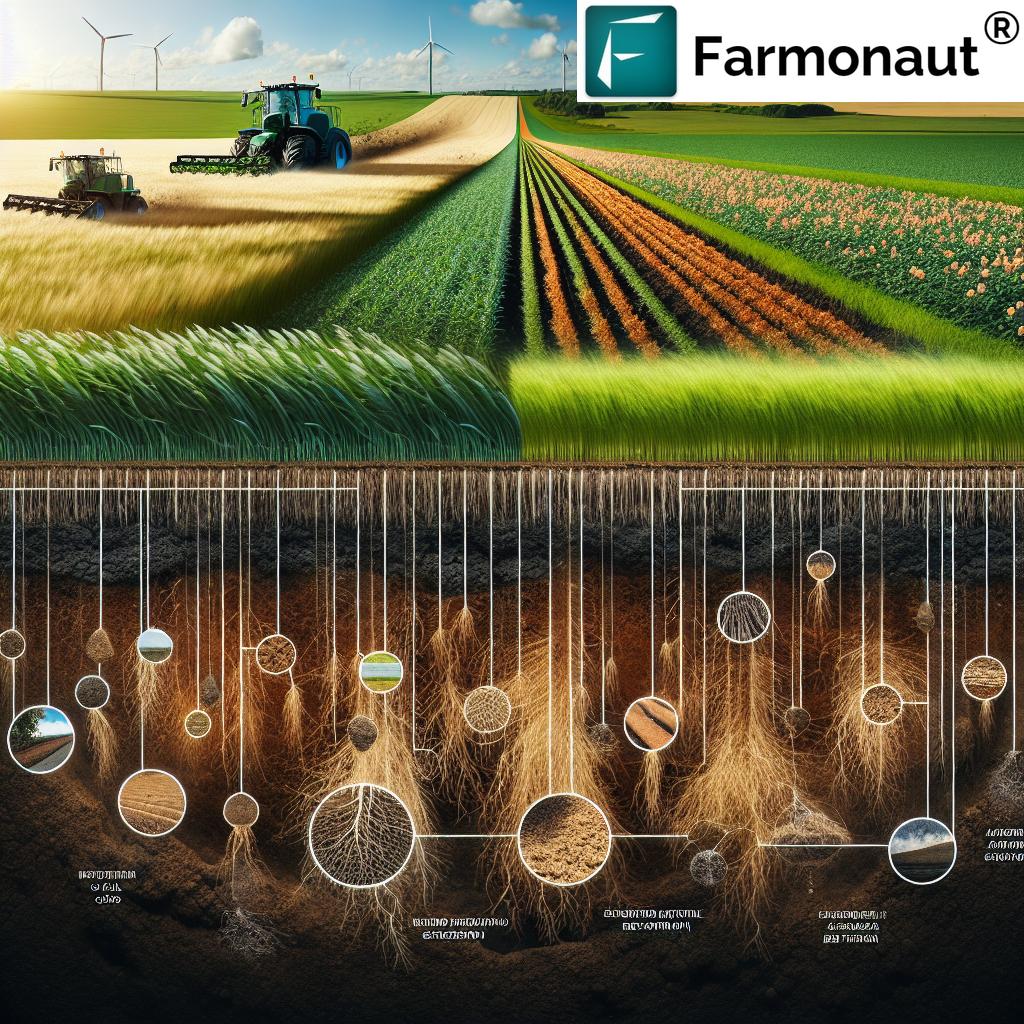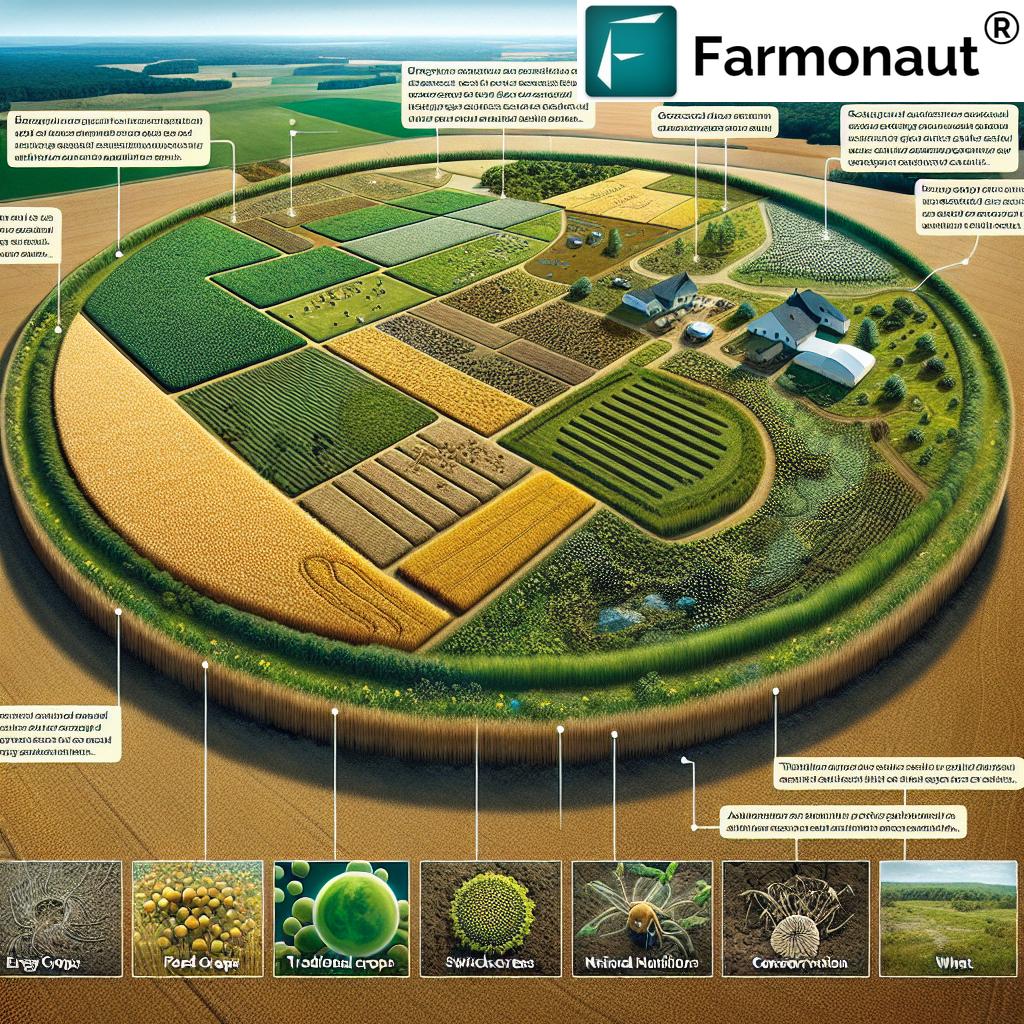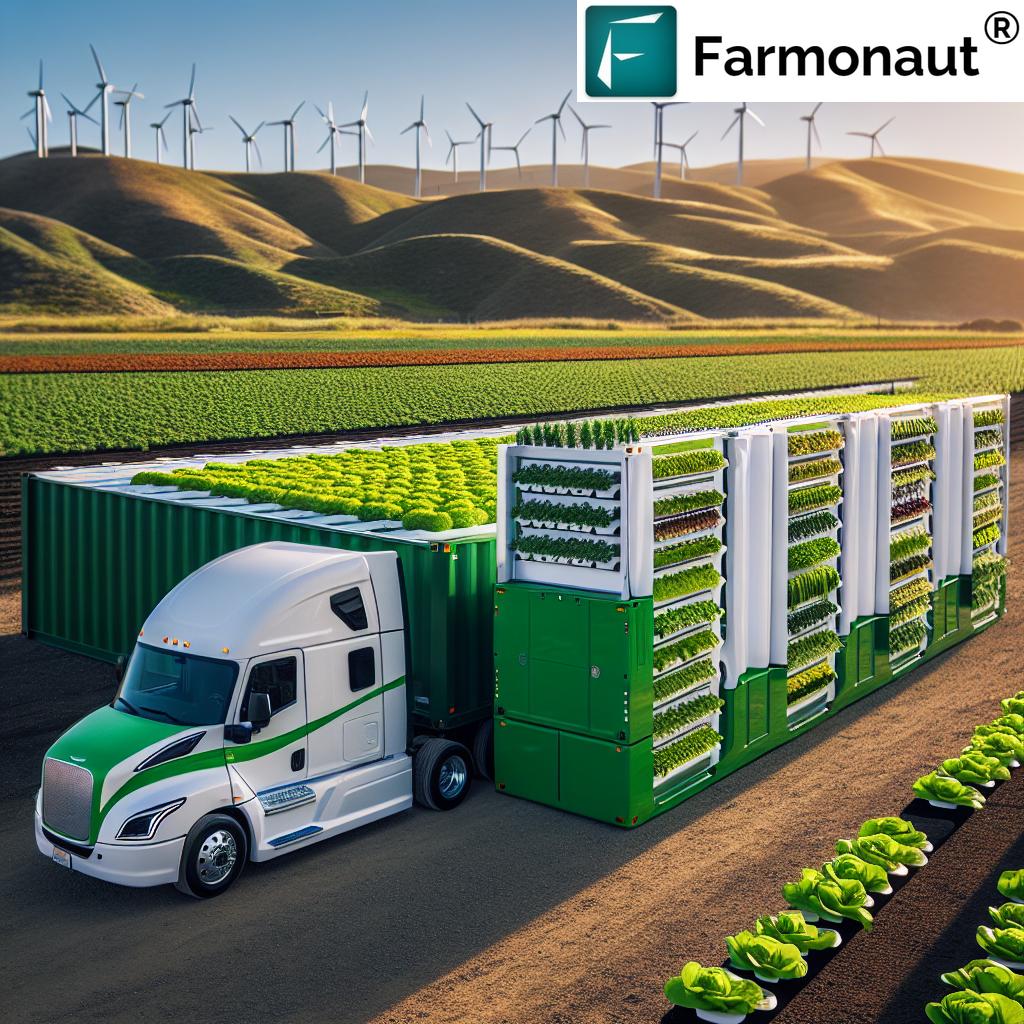Sustainable Agriculture Practices: Balancing Energy Crops and Soil Health for a Greener Future in Madison, WI
“Warm-season grasses and woody crops can sequester up to 2.5 tons of carbon per hectare annually in soil.”
In the heart of America’s Dairyland, Madison, Wisconsin, we find ourselves at the forefront of a green revolution in agriculture. As we navigate the challenges of climate change and the growing demand for sustainable energy sources, the balance between energy crop production and soil health has never been more critical. At Farmonaut, we’re committed to leveraging cutting-edge technology to support farmers in this crucial endeavor.

As we delve into the world of sustainable agriculture practices, we’ll explore how energy crops impact soil health, the role of crop residue management in soil carbon sequestration, and the environmental benefits of warm-season grasses. Our journey will take us through the fields of agronomy research, the production of cellulosic ethanol, and the innovative approaches to cultivating marginal lands.
The Rise of Energy Crops in Madison’s Agricultural Landscape
Madison, WI, with its rich agricultural heritage, is witnessing a transformation in farming practices. Energy crops, particularly warm-season grasses and woody crops, are emerging as promising alternatives for biomass production and cellulosic ethanol. These crops not only offer a renewable energy source but also play a crucial role in mitigating climate change impacts.
- Warm-season grasses like switchgrass and miscanthus
- Woody crops such as poplar and willow
- Dual-purpose crops that provide both food and energy
The adoption of these energy crops is reshaping the agricultural landscape of Madison and surrounding areas. Farmers are increasingly recognizing the potential of these crops to diversify their income streams while contributing to environmental sustainability.
Balancing Biomass Production and Soil Health
One of the primary challenges in cultivating energy crops is maintaining a delicate balance between biomass production for biofuels and preserving soil health. At Farmonaut, we understand the importance of this balance and offer advanced satellite-based monitoring solutions to help farmers make informed decisions.
Our satellite imagery and AI-powered analytics provide real-time insights into crop health, soil moisture levels, and other critical metrics. This data-driven approach enables farmers to optimize their energy crop cultivation while minimizing negative impacts on soil structure and fertility.
The Role of Crop Residue Management in Soil Carbon Sequestration
Crop residue management is a critical aspect of sustainable agriculture practices, particularly when it comes to soil carbon sequestration. The proper handling of crop residues can significantly impact soil organic carbon levels, soil structure, and water conservation.
“Removing 25% of crop residue can reduce soil organic carbon by up to 10% over a decade.”
This startling statistic underscores the importance of careful crop residue management. At Farmonaut, we provide farmers with tools to monitor and manage their fields effectively, ensuring that crop residues are utilized optimally for soil health and carbon sequestration.
- Reduced tillage practices to preserve soil structure
- Incorporation of crop residues into the soil
- Cover cropping to enhance soil organic matter
By implementing these practices, farmers in Madison and beyond can contribute significantly to soil carbon sequestration while maintaining productive energy crop systems.
Environmental Benefits of Warm-Season Grasses
Warm-season grasses, such as switchgrass and big bluestem, offer numerous environmental benefits when integrated into agricultural systems. These grasses are not only efficient in biomass production but also play a crucial role in enhancing ecosystem services.
- Deep root systems that improve soil structure and water retention
- High carbon sequestration potential
- Habitat provision for wildlife and pollinators
- Reduced soil erosion and improved water quality
Our satellite-based monitoring at Farmonaut allows farmers to track the growth and health of these warm-season grasses, ensuring they maximize both biomass production and environmental benefits.
Explore our API for advanced agricultural insights
Advancements in Agronomy Research for Sustainable Energy Crop Production
The field of agronomy is rapidly evolving, with researchers in Madison and around the world making significant strides in understanding the complexities of energy crop cultivation. These advancements are crucial for developing sustainable practices that balance productivity with environmental stewardship.
- Genetic improvements for enhanced biomass yield and stress tolerance
- Optimized fertilization strategies to reduce environmental impact
- Integration of precision agriculture technologies for efficient resource use
At Farmonaut, we’re committed to supporting this research by providing cutting-edge tools for data collection and analysis. Our satellite imagery and AI-powered insights contribute valuable data to agronomists and researchers, helping to accelerate the development of sustainable energy crop systems.
Cellulosic Ethanol Production: A Sustainable Biofuel Solution
Cellulosic ethanol, derived from non-food plant materials, represents a promising avenue for sustainable biofuel production. Madison, WI, with its strong agricultural base and research institutions, is well-positioned to lead in this field.
- Utilization of agricultural residues and dedicated energy crops
- Reduced competition with food production
- Lower greenhouse gas emissions compared to conventional ethanol
The production of cellulosic ethanol aligns with our mission at Farmonaut to promote sustainable agricultural practices. Our technology helps farmers optimize their energy crop production, ensuring a steady and efficient supply of biomass for ethanol production.
Access our API Developer Docs for in-depth agricultural data

Cultivating Marginal Lands: Opportunities and Challenges
The cultivation of energy crops on marginal lands presents a unique opportunity to expand biofuel production without compromising food security. However, this approach comes with its own set of challenges that require careful consideration and innovative solutions.
- Identification of suitable energy crop species for marginal conditions
- Development of soil improvement strategies
- Water management in drought-prone areas
Farmonaut’s satellite-based monitoring systems are particularly valuable in managing marginal lands. Our technology allows farmers to track soil moisture levels, identify areas of stress, and make data-driven decisions to optimize crop growth in challenging conditions.
Ecosystem Services in Agriculture: Beyond Crop Production
When we consider sustainable agriculture practices, it’s essential to look beyond mere crop production and consider the broader ecosystem services provided by agricultural lands. In Madison, WI, and across the globe, there’s growing recognition of the multifunctional role of agriculture in supporting environmental health.
- Carbon sequestration and climate regulation
- Water filtration and flood mitigation
- Biodiversity conservation
- Pollinator habitat provision
At Farmonaut, we’re committed to helping farmers understand and maximize these ecosystem services. Our advanced monitoring tools provide insights into various aspects of field health, enabling farmers to make decisions that enhance both productivity and ecological benefits.
The Future of Sustainable Agriculture: Integrating Technology and Traditional Wisdom
As we look to the future of sustainable agriculture in Madison and beyond, it’s clear that the integration of cutting-edge technology with traditional farming wisdom will be key. This synergy is essential for developing resilient agricultural systems that can meet the challenges of climate change and increasing global food demand.
- AI-driven farm management systems
- Precision agriculture techniques for resource optimization
- Blockchain technology for supply chain transparency
- Remote sensing for large-scale crop monitoring
Farmonaut is at the forefront of this technological revolution in agriculture. Our platform combines satellite imagery, AI, and machine learning to provide farmers with actionable insights for sustainable crop management.
Comparison of Energy Crops and Their Impact on Soil Health
| Energy Crop Type | Biomass Production Potential (tons/acre/year) | Cellulosic Ethanol Yield (gallons/ton) | Soil Carbon Sequestration Rate (tons CO2/acre/year) | Impact on Soil Structure | Water Conservation Effect | Suitability for Marginal Lands |
|---|---|---|---|---|---|---|
| Switchgrass | 5-10 | 80-100 | 0.5-1.5 | High | Good | High |
| Miscanthus | 10-15 | 90-110 | 1.0-2.0 | High | Good | Medium |
| Poplar (Short Rotation) | 4-7 | 70-90 | 0.7-1.7 | Medium | Moderate | Medium |
| Willow (Short Rotation) | 4-6 | 65-85 | 0.6-1.5 | Medium | Good | High |
| Energy Sorghum | 8-12 | 75-95 | 0.3-0.8 | Low | Poor | Low |
This table provides a comprehensive overview of various energy crops and their impacts on soil health and ecosystem services. It’s evident that each crop type has its unique strengths and challenges, emphasizing the need for careful selection based on local conditions and sustainability goals.
Policy Implications and Global Land Management
The shift towards sustainable agriculture practices and energy crop production has significant policy implications, both in Madison, WI, and on a global scale. Policymakers are increasingly recognizing the need for regulations and incentives that promote sustainable land management practices.
- Carbon credit systems for agricultural carbon sequestration
- Subsidies for sustainable farming practices
- Regulations on crop residue management
- Support for research and development in sustainable agriculture
At Farmonaut, we provide data and insights that can inform these policy decisions. Our satellite-based monitoring systems offer a bird’s-eye view of agricultural practices, helping policymakers understand trends and impacts on a large scale.
Education and Career Development in Sustainable Agriculture
As the field of sustainable agriculture continues to evolve, there’s a growing need for educated professionals who can navigate the complexities of modern farming. Madison, WI, with its renowned educational institutions, is well-positioned to lead in this area.
- Specialized degrees in sustainable agriculture and agroecology
- Continuing education programs for working professionals
- Internship opportunities with innovative agtech companies
- Research fellowships in energy crop development and soil science
Farmonaut is committed to supporting education in sustainable agriculture. We offer resources, webinars, and training programs to help students and professionals stay at the forefront of agricultural technology and practices.
Conclusion: A Greener Future for Madison and Beyond
As we’ve explored throughout this blog, the future of sustainable agriculture in Madison, WI, and across the globe is bright but challenging. Balancing energy crop production with soil health requires a multifaceted approach that combines cutting-edge technology, sound agronomic practices, and a commitment to environmental stewardship.
At Farmonaut, we’re dedicated to supporting farmers, researchers, and policymakers in this crucial endeavor. Our satellite-based monitoring systems, AI-powered analytics, and comprehensive farm management tools provide the insights needed to make informed decisions for a sustainable agricultural future.
By embracing sustainable practices, leveraging technology, and fostering innovation, we can create a greener future where energy production and environmental conservation go hand in hand. The journey towards sustainable agriculture is ongoing, but with collaboration and dedication, we can achieve a balance that benefits both our planet and our communities.
FAQ Section
Q: What are energy crops, and how do they differ from traditional food crops?
A: Energy crops are plants grown specifically for biofuel production or energy generation. Unlike traditional food crops, they are not intended for human or animal consumption. Examples include switchgrass, miscanthus, and short-rotation woody crops like poplar and willow.
Q: How do energy crops impact soil health?
A: Energy crops can have both positive and negative impacts on soil health. Many perennial energy crops, like switchgrass, have deep root systems that can improve soil structure, increase organic matter, and enhance carbon sequestration. However, improper management or excessive biomass removal can lead to soil degradation.
Q: What is cellulosic ethanol, and why is it important?
A: Cellulosic ethanol is a biofuel produced from non-food plant materials such as agricultural residues, wood chips, or dedicated energy crops. It’s important because it offers a more sustainable alternative to corn-based ethanol, reducing competition with food production and potentially lowering greenhouse gas emissions.
Q: How can farmers balance energy crop production with food crop cultivation?
A: Farmers can achieve this balance through several strategies:
– Rotating energy crops with food crops to improve soil health
– Cultivating energy crops on marginal lands unsuitable for food production
– Implementing agroforestry systems that combine woody energy crops with traditional agriculture
– Using precision agriculture techniques to optimize resource use for both energy and food crops
Q: What role does technology play in sustainable agriculture practices?
A: Technology plays a crucial role in sustainable agriculture by:
– Providing real-time data on crop health and soil conditions
– Enabling precision application of inputs like water and fertilizers
– Facilitating better decision-making through AI-powered analytics
– Improving traceability and transparency in the agricultural supply chain
– Enhancing monitoring and management of large-scale farming operations
















